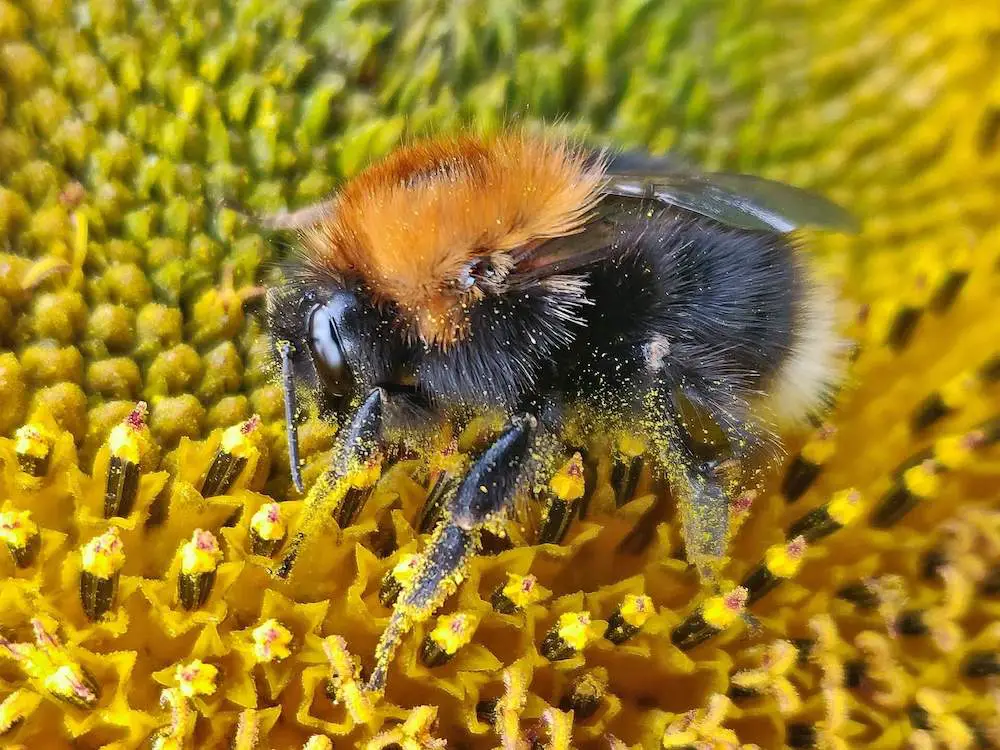Last updated on January 3rd, 2024 at 01:52 pm
The Tree bumblebee, Latin name Bombus hypnorum of the genus Bombus is a species of bumblebee present across parts of Europe and Asia. Despite its fast spread across mainland Europe and the UK this species is still not currently found in the Mediterranean or large swathes of Eastern Europe.
What do Tree bumblebees look like?
Tree bumblebees display lots of characteristics synonymous with bumblebees like a rounded head and short proboscis. Perhaps the most distinguishable and easily identifiable difference is the ginger/reddish-brown hair displayed across the thorax in combination with a black abdomen and white tail, similar to the White-tailed bumblebee.
It’s worth noting thatthe ginger/reddish-brown hair displayed across the thorax can be worn away over time creating a ‘blad patch’ that can make the bee’s appearance much darker.
Males of the species are approximately twice the size of a Western honeybee and display larger antennas than workers and queens. Young males will also display some yellow hairs across their facial area that fade as the bee matures and ages.

What does a Tree bumblebee queen look like?
Other than their larger size it can be very hard to discern any visible differences between workers and the queen. Queen Tree bumblebees are usually between 16mm and 22mm in length with worker Tree bumblebees usually around 10mm to 12mm long.
How do Tree bumblebees build their nests?
Tree bumblebees build their nests in holes in tree trunks, stumps, and hollow stems. They can often choose to occupy old wasp nests or abandoned bird nests that are no longer in use.
Where do they build their nests?
Tree bumblebees build their nests in a variety of locations, but here are some of the most common places you might find a nest.:
- Under the bark of trees
- In hollow twigs
- In tree holes or crevices
- In abandoned wasp nests
The lifecycle of a Tree bumblebee
A Tree bumblebee’s life is a busy one. It starts out as an egg, which hatches into a larva. The larva will then grow before becoming a pupa, which eventually turns into an adult bee.
The Tree bumblebee has many stages in its life cycle. Here’s what each stage looks like:
- Eggs: The female Tree bumblebee lays about 1,000 eggs at once on the underside of leaves or other soft surfaces in its nest.
- Larvae: When the eggs hatch, the larvae emerge and begin eating the food provided by their mother.
- Pupae: The pupae are inactive during this stage of development while they wait for their bodies to fully mature and harden into adult bees. They also develop compound eyes during this time, which they did not have as larvae.
The video below highlights some of the Tree bumblebee’s daily activities in a sunny garden in the UK.
Habitat
The Tree bumblebee, (Bombus hypnorum), is believed to be a relatively recent introduction to Britain. It’s also found in France, Belgium and the Netherlands.
The Tree bumblebee has a very broad range of plants and flowers that it visits for pollen and nectar so it’s a common sighting all across the UK in a range of habitats from wetlands, lowlands, gardens, meadows, etc
It has been shown that this species can co-exist with honey bees in orchards when they are both provided with nest boxes.
Can Tree bumblebees sting?
Yes, females of the species are equipped with a sting to defend themselves against attackers. If a Tree bumblebee worker feels threatened they can and will sting humans and pets.
Do Tree bumblebees produce honey?
Yes, but not in the same abundance as their close relative the honeybee. Tree bumblebees produce small amounts of honey to feed the hive’s inhabitants through spring and summer but do not create any stores for winter. While this is called ‘honey’ it is much closer to raw nectar and does not go through the same dehydration and purification process of normal honey produced by honeybees.
Are Tree bumblebees rare?
Tree bumblebees are common across the United Kingdom and Europe and can even be found in parts of Asia. You’re most likely to see a Tree bumblebee between late March and July.



